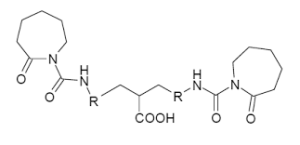Tetramethoxymethyl glycoluril (TMMGU),TGIC Replacement Chemistries

Tetramethoxymethyl glycoluril (TMMGU),
TGIC Replacement Chemistries
Hydroxyl polyester/TMMGU combinations,such as powderlink 1174,developed by Cytec, may offer an excellent opportunity to replace TGIC in applications that require thinner film builds. As this chemistry’s cure mechanism is a condensation reaction, some of the application problems described in the section on HAA curatives also occur with this curative. However, recent evaluations and data show that pin hole free coatings can be obtained with hydroxyl polyester / TMMGU combinations even when film builds exceed 4 mils
This type of chemistry needs a strong acid catalyst, such as methyltolylsulfonimide (MTSI) or cyclamic acid (CA). Acid catalysts have some drawbacks : long-term storage of acid-catalyzed electrostatic powder coating can alter the reactivity of such systems. And some acid catalysts can be affected , or even neutralized, by basic pigments or fillers, such as calcium carbonate , unless these inerts are pretreated or coated .
The use of acid catalysts may cause powder formulators problems in terms of catalyst dosage and choice of fillers. Precatalyzed (internally catalyzed ) resins have become commercially available , offering an alternative to formulating with , and handling of ,acid catalysts. The biggest disadvantage of precatalyzed resins is that they do not allow formulators to modulate the cure of TMMGU systems
Blocked and unblocked acid catalyts work with TMMGU type chemistries . Since TMMGU systems that contain blocked acids have to unblock to become active,they generally need higher bake temperatures or longer bake times than formulas that contain unblocked acids. Blocked acids have better storage stability and a higher tolerance for basic pigments and fillers than do unblocked acids, however. Moreover,recent work with nonyellowing amine blocked MTSI has produced powder that builds to a thickness of 4 to 5 mils (100 to 125 microns) without detectable defects. The advantage of unblocked acids is that they offer cure temperatures that are typically lower than those for TGIC or IPDI systems.
MTSI produces high-gloss finishes whereas CA produces products with gloss ranges between low and intermediate without the need for flatting agents . Dead-flat films can be obtained by adding small amounts of CA to precatalyzed resin.
The condensation product from the polyester/TMMGU reaction is methanol , which raises some environmental concerns,especially for powder coatings applicators. Cure volatile levels for methanol have been measured at about 1 to 1.5 percent of total formulation weight. TMMGU also releases 300 to 600 ppm of formaldehyde (on paint solids) during cure. This ,however,is about 20 times less than the amount a melamine aminoplast curative produces in conventional coating.
On the positive side , TMMGU system offer a wide variety of products possibilities ranging from extremely flexible to very hard,nonyellowing coatings. Flow , leveling, and weathering properties are generally very good to excellent .QUV data from powders formulated with clear hydroxy polyester/TMMGU /MTSI systems indicate that such powders retain more than 70 percent of gloss after 1000hours of exposure when they are formulated without UV absorbers. When formulated with UV absorbers,the powders retain 85 to 90 percent of gloss. This compares favorably with TGIC and IPDI systems. In Florida exposure testing , some TMMGU systems have withstood 20 months of weathering without any noticeable loss of gloss.
Tetramethoxymethyl glycoluril (TMMGU)
